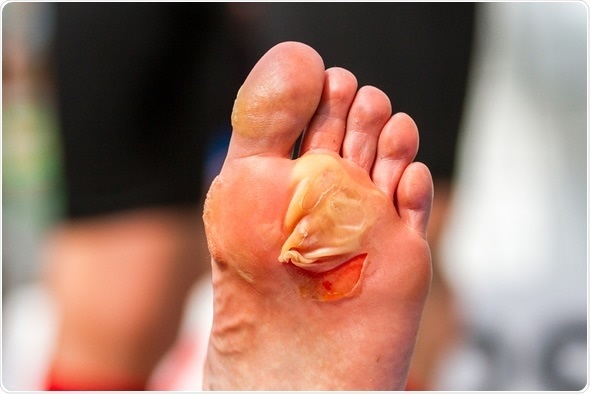Blisters on feet occur for different reasons, they vary in size and location. A blister is a small pocket of clear fluid in the upper layer of the skin, in an area of the body. Blister on toe or the foot can interfere with everyday tasks like walking, standing and exercising. There are home treatments that relieve the discomfort of the foot blister.

Causes of blisters on feet
- Sometimes one puts pressure on the feet with long hours of standing and walking which leaves you susceptible to blisters on the feet. A friction blister is caused by poorly fitting shoes; too loose and too tight-fitting shoes rub against the skin.
- Excess perspiration or moisture triggers the blisters, especially during warm seasons.
- Dyshidrotic eczema – a skin condition that has blisters develop on the soles of the feet and the palms of the hands. The blisters are itchy and last two to four weeks. You are at a greater risk of Dyshidrotic eczema if you have high levels of emotional or physical stress.
- Allergic reactions
- Fungal infections
- Exposure to chemical products such as detergents or cosmetics.
- Frostbite
- Bacterial infection
- Chickenpox
- Herpes
Some blisters resolve within a few days, but some cause severe pain preventing walking and standing. If you are looking for some expert advice on foot blisters, you may want to seek help from a podiatrist. Feel free to contact our office to make an appointment with our podiatrist. Our Houston podiatrist, Dr. Ejodamen Shobowale can provide you with the care you need to keep you pain-free and on your feet.
Home treatment
That pocket of water is very uncomfortable and tempting, especially because you feel the need to pick or burst it. Open blisters could lead to infections, so they should be left alone to harden and disappear.
Soak your feet in cool water or apply cold compresses to reduce itchiness, at least two times a day for 15 minutes each time.
Then apply rich moisturizers such as petroleum jelly, heavy creams, soaking with witch hazel, mineral oil, or ointment.
If the blisters are because of eczema you might need to change your diet to avoid flare-ups. Consult your doctor for advice on what to take and what not to take.
Blister Treatment
- If the blister is not popped cover it loosely covered with a bandage or leave it uncovered. If the blister is at the bottom of the foot, relieve the pressure on it by putting donut-shaped moleskin.
- For a popped blister wash gently with warm water and soap. Do not use iodine, alcohol or hydrogen peroxide. Level down the skin, then apply antibiotic ointment to the area. With a sterile bandage cover the area loosely.
When to drain a blister
If a blister is painful, or large or in an awkward position it can be drained. First part of the blister treatement includes, washing your hands with antibacterial soap, then use a clean cotton swab dipped in an antiseptic to clean the blister. Sterilize a needle with rubbing alcohol and make a small hole at the edge of the blister. Gently squeeze the fluid out then wash the area again and pat dry. Leave the skin on and apply ointment and cover with a sterile bandage. Ensure you clean and reapply antibacterial ointment daily until it heals.
Daily care
Change the bandage daily or if it gets wet and dirty. Avoid situations that caused the blisters and avoid wearing shoes to ease the pressure. If you notice signs of infections such as red streaks leading away from the blisters, pus, swollen lymph glands, increased swelling and pain, fever, and if it is more than 10 years since you got your tetanus, seek medical help.
If you have any questions, please feel free to contact our office located in Houston, TX. Our Houston foot doctor can handle all of your foot and ankle issues. We will provide you with the latest diagnostic and treatment methods for all foot blister related issues.